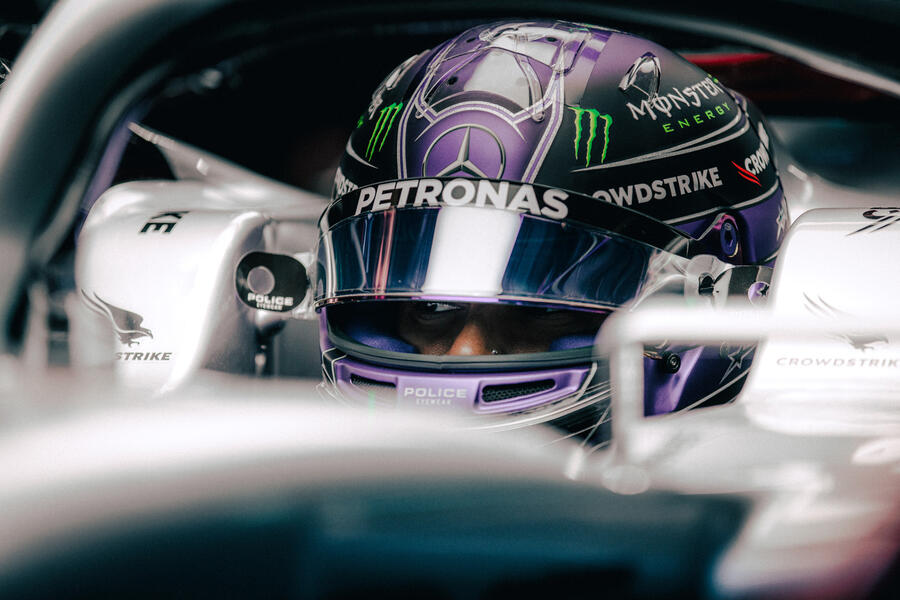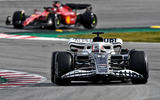“Last season was one of the best in the history of Formula 1. It’s just a shame that the final 10 minutes undid 10 months of brilliance.” Karun Chandhok, former F1 driver and now Sky F1 pundit, is typically outspoken as we look out from Silverstone’s new Interactive Museum over the circuit.
We’re here to talk about the upcoming 2022 season and how the biggest changes in the sport’s regulations for four decades will bear upon it. And since a significant chunk of those regs will have a direct effect on the cars’ dynamics, we’ve also brought along Rob Wilson, driver coach to some of the world’s best.
Wilson’s techniques have been adopted by around 75 drivers over the past four decades, including nine on this year’s grid, so will he need to tweak his tuition?
But first, some lines need drawing. “Let’s be very clear,” says Chandhok, “[then race director] Michael Masi made a mistake in Abu Dhabi. He should have asked all the lapped cars to go past on lap 56 and pulled the safety car in on lap 57; then they would have had one racing lap on lap 58. What everyone wants to know is what happened in Masi’s mind in the four minutes between the ‘lapped cars will not be passed’ message and the next one, which said ‘five lapped cars will be passed’.”

So how would Chandhok prevent a repeat of this incident? “If there’s an accident in the last six laps of the race, just do a red flag; then you will have an entertaining finish from a standing start.”
And while it’s clear that this kind of drama is dearly needed in the sport, it’s also something that needs cohesive race direction, which both Chandhok and Wilson feel might be lacking now that Niels Wittich and Eduardo Freitas are alternating between races. “There’s going to be inconsistency, because there are two,” says Wilson. “And then there will be complaints that there are two. There should be just one [for every race].”
Will the new Virtual Race Control Room – effectively F1’s version of football’s video assistant referee – help them arbitrate over any grey areas when penalties are being applied?
Once again, Chandhok is cautious about the system’s efficacy: “I’m glad they’re trying different things, but it will slow the decision-making process. [The current five-person panel will be joined by a four-strong FIA panel to make rulings.] I have a bad feeling that they will say ‘we will investigate after the race’. But for now, let’s give it the benefit of the doubt.”
It’s clear, though, that everyone’s focus this season will be on the cars themselves, which now adopt ground-effect aerodynamic strategies not seen since the early 1980s, reducing the impact of ‘dirty air’ and increasing cornering speeds for following cars. Chandhok is certain that this will increase overtaking opportunities and improve racing.
“Since 1998, this following problem has got worse. Last season, people were picking up a slipstream four and a half seconds out. In 2022, if you’re two to three seconds behind, it will be easier to follow the car in front; and when you get through six-tenths, you’re straight up there. They initially said that it was going to be 27% better. I don’t believe that will be the case, but I think it will be 10-15% better. The point is that if we didn’t do it, it would just get worse. And you know what? The cars look great; they look like a step into a new era.”

An overall wheel-diameter increase from 13in to 18in and a far lower tyre profile have also been implemented, and Chandhok and Wilson foresee changes for both teams and drivers. “I’ve done a lot of testing with higher- and lower-profile tyres,” says Wilson.
“The higher profile is always lazier during cornering, but the lower profile will give it more bite initially, although the [car’s] weight will be transferred to the surface more brutally. A softer movement behind the wheel – a tinier introduction of the steering – is going to help.”
Chandhok agrees and adds: “The wheels and tyres, I think, are collectively around 22kg heavier. The mechanics have had to get stronger; they’re struggling to do the pit stops as quickly as they used to.”
Will the new cars change the dynamic of races and bring a fresh challenge for the front-runners? “I think you will still have that close fight with the midfield teams, like Aston Martin, Alpine, McLaren and AlphaTauri,” says Chandhok, “but the gap between the haves and have-nots will get bigger in 2022. The cars have been drawn up based on theory, so those with the best wind-tunnel and CFD capabilities will have an advantage. However, because there’s less flexibility in the rules, I think the have-nots will catch up quicker than before.”
Technical changes aside, the hard-fought battle between two of F1’s greatest protagonists in recent years is set to continue, with Wilson seeing their psychological approaches to racing as the biggest differentiator: “Max [Verstappen] is slightly quicker, takes more chances. Lewis [Hamilton] is a brilliant driver, but mid-race, when he’s not winning, the call from him is always ‘what can you do for me?’, whereas Max’s view is just ‘I’m going to go fast’. Max wants to win, Lewis wants to finish first, and there’s a difference.”

Chandhok concurs: “There’s a parallel between [Alain] Prost and [Ayrton] Senna and Lewis and Max. By the time their rivalry intensified in 1989, Prost had been in F1 for a decade. Senna was younger, hungrier and more aggressive. I see a lot of Prost in Lewis. He has become so methodical. He’s not bothered about getting pole any more. He sets it up to manage tyres and fuel. That’s all Prost.”
Of the midfielders, the pair rate Aston Martin’s Sebastian Vettel and Lance Stroll. “Being at Ferrari those past couple of years was soul-destroying for Vettel, but he has rediscovered his mojo at Aston,” says Chandhok.
“It’s quite hard to judge [the team’s performance] last year because the cars took a step backwards, with the aero rule change and the flow change. Their season was a mess, but 2022 will be an interesting year for them.”
Wilson believes we shouldn’t discount Stroll, either: “He’s becoming a very fine driver and is going as fast as Vettel a lot of the time.”
Chandhok also thinks that Ferrari has a real opportunity to turn the ‘big two’ into the ‘big three’: “Ferrari gets 10% more wind-tunnel time than Mercedes [based on championship placings]. They’ve not been in a title fight, so they’ve been able to focus their resources on 2022. It’s going to be a big year for them.”

We discuss Haas and driver Nikita Mazepin. As a Motorsport UK board member, Chandhok supports the organisation’s stance on Russian licence holders in light of the invasion of Ukraine: “We’re effectively asking them to delink themselves from Russia, which is the right thing to do.”
Just two days after we meet, Mazepin and Russian title sponsor Uralkali are ‘delinked’ from Haas entirely, with Kevin Magnussen drafted in to take his place.
But although the team will surely benefit from the returning Dane’s talents, he’s unlikely to stir up the order more than a certain young Brit. “I’ve spent time with George [Russell], and I didn’t find him that different to Esteban Ocon,” says Wilson. “He’s brilliant, but boy is he ruthless – and fast.”
His style reminds Chandhok of Mika Häkkinen: “It is very minimalist, very deliberate. Whereas Max and Lewis will rotate the car on the brakes, George is all about angles and straight lines.”
One thing is for sure, though: with demand for greater clarity about the rules and a return to chassis designs that should release not only a car’s but also a driver’s potential, 2022 will be an F1 season to remember – and hopefully for all the right reasons.
What should power F1 cars in future?

After the FIA imposed a freeze on F1 powertrain development until 2026, Karun Chandhok believes it should rethink its future strategy.
“We need to get rid of hybrids,” he explains. “F1 cars are too fat and heavy now [the minimum has risen to 795kg]. The MGU-H [weighing 120kg] will never find its way on to a road car; it’s irrelevant. The FIA needs to say: ‘Formula E, you’re purely electric; sports cars, you’re developing hybrids; F1, you’re developing sustainable fuels.’
“So we will have a return to V10s and V12s that everyone likes to hear. F1 needs to drive the change for what’s coming in 2035, not in 2030.”
2022 F1 Calendar
Sakhir, Bahrain: 20 March
Jeddah, Saudi Arabia: 27 March
Melbourne, Australia: 10 April
Imola, Italy: 24 April
Miami, Florida, US: 8 May
Barcelona, Spain: 22 May
Monte Carlo, Monaco: 29 May
Baku, Azerbaijan: 12 June
Montreal, Canada: 19 June
Silverstone, UK: 3 July
Spielberg, Austria: 10 July
Le Castellet, France: 24 July
Spa-Francorchamps, Belgium: 28 August
Zandvoort, Netherlands: 4 September
Monza, Italy 11: September
To be confirmed: 25 September
Marina Bay, Singapore: 2 October
Suzuka, Japan 9: October
Austin, Texas, US: 23 October
Mexico City, Mexico: 30 October
São Paulo, Brazil: 13 November
Yas Marina, Abu Dhabi, UAE: 20 November
Simon Hucknall























Join the debate
Add your comment
Sore losers. Didn't bother with the rest of the article.